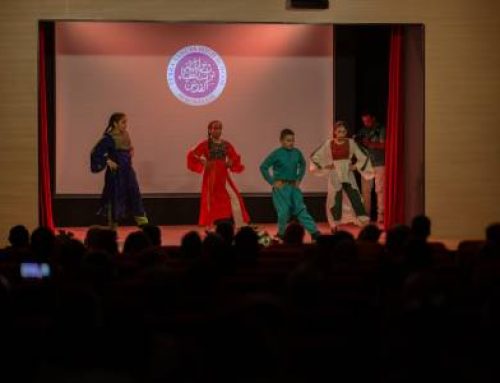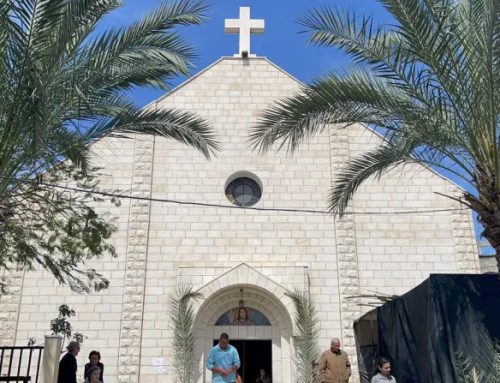I feel very much like the woodpecker outside our window. For some unknown reason he has taken on the avian equivalent of a Herculean task. He is attempting to peck his way through a metal strip to reach the succulent insects hiding in the wood pole beneath the strip. Doubtless he has other sources of nutrition, judging by the fact that his vigor seems undiminished even though he is a long, long way from breaking through to the more yielding wood, even after countless hours of effort.
Russell O. Siler, Retired
Now for what I haven’t told you…Our window is high above the Old City of Jerusalem, on the Mount of Olives. We are in the midst of a three-week visit, renewing friendships and gaining an up-to-date perspective on the circumstances here. And the reason for my identification with that red-headed winged worker is that sometimes I feel as if my small efforts and those of thousands of people like me are just as fruitless when it comes to piercing the nearly impenetrable bands which encircle and enshroud the life-wasting tragedy that is Israel and Palestine. Now let no one doubt that I fully understand that there are two narratives symbiotically and inextricably intertwined in this place…that an unaimed, yet potentially deadly rocket heading toward an Israeli town in the Negev and a 500-pound bomb headed toward a civilian center in Gaza are both terrifying and they are both to be condemned…that even a cursory reading of the history of the region reveals a litany of violence and retaliation that has left neither the Israeli people nor the Palestinian people with clean hands…and that no serious person with a rudimentary grasp of the past and the present believes that a resolution of the terrible crisis here can rest on an accounting of the past sins of either or both parties.
But I also understand that this is not an “Arab-Israeli-Palestinian conflict” as some would describe it. The matter at hand is between the nation of Israel and the Palestinian people of the West Bank, Gaza, and East Jerusalem. To term it an Arab-Israeli conflict is roughly equivalent to naming a struggle between Cuba and the United States a Latin America-U.S.A. struggle. Certainly there are Arab groups and nations who have weighed in from time to time with threats and violence toward Israel, and there is some measure of that today, just as there is a large measure of military and strategic support which the U.S. has long provided Israel, as well as America’s willingness to stand idly by and allow the illegal settlement activity to continue on confiscated Palestinian land.
Let us be clear about the Arabs and the Israelis. Israel and Egypt have co-existed under an Israel-Egypt Peace Agreement since 26 March 1979–thirty years–and the Israel-Jordan Peace Treaty was signed 26 October 1994. These two Arab countries make up the lion’s share of the land borders of Israel. This does not guarantee peace in the future with those nations, but the history strongly suggests that at least these Arab states–after decades of warfare–now consider peace and normalized relations with Israel to be in their best national interests. Even Israel-Syria relations, which have been very contentious in the past, have been marked by intermittent peace talks and negotiations ever since the Madrid Peace Conference in 1991. It is impossible to know the outcome at this point, especially giving the Gaza invasion and the newly-formed right-wing Netanyahu government, but the continuing nature of such conversations suggests that both nations see the benefits of negotiated agreements. The nation which Israel seems to regard as its greatest threat–Iran– is not even an Arab nation. Thus we have only the perceived danger from Lebanon and its Hezbollah party along with Iraq
There is yet one thing more–the occupation. About four years ago a former U.S. government official came to Jerusalem to speak about the possibilities for peace in the Middle East. I did not hear him, but I clearly remember my friend’s report and comment the next day: “He spoke for 40 minutes and never once mentioned the occupation.” I have read documents which purport to be fair and balanced proposals to church bodies for peacemaking efforts in the Middle East. Yet some of them never mention the occupation. How can this be! There can be a variety of differing opinions on the Israeli-Palestinian question. There are a number of valid perspectives. But there are also indisputable facts. Israel has been in complete civil and military control of Gaza, East Jerusalem, and the West Bank since 1967, able to dictate to Palestinians about every aspect of their lives: particularly daily movement, agriculture, education, and residence. Since the Annapolis Conference of 2007 during which Israel promised to reduce the number of checkpoints and other impediments to movement in the Occupied Territories, the number of checkpoints in the West Bank and East Jerusalem has–according to the U.N.–actually increased. Remember that these barriers are largely within the territories, not on the lines between Israel and the Palestinian area. Nearly one-half million illegal Israeli settlers now live in the West Bank and East Jerusalem. They are subsidized by the government of Israel, protected by the police and the army, and they drive on roads from which Palestinians are excluded. I have yet to hear the first Palestinian speak to deny Israel the right to build its 27-foot high wall and fence, but they all add, “…as long as they build it on their own land.” I have yet to hear a single Israeli supporter explain why the barrier takes away fully 10% of all Palestinian lands by virtue of its route through the West Bank. Perhaps it is because they cannot do so without acknowledging that the route of the fence/wall goes deeply into the West Bank to encompass large illegal settlements as well as to insure that Israel maintains control of the vital aquifers beneath the land.
I, too, want peace with all my heart, but I also want justice. For two peoples to be able to move toward mutually assured security, prosperity, and self-determination, we must first acknowledge the realities. Working together we can move beyond the formidable obstacles now all around us. First, however, we must agree to face the facts…honestly.
Russell O. Siler, Retired





